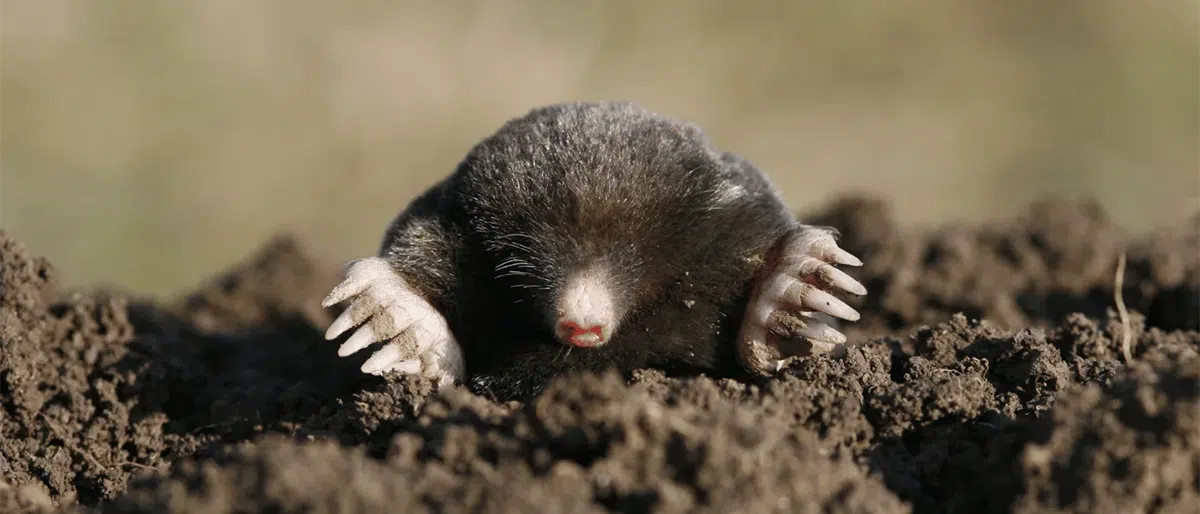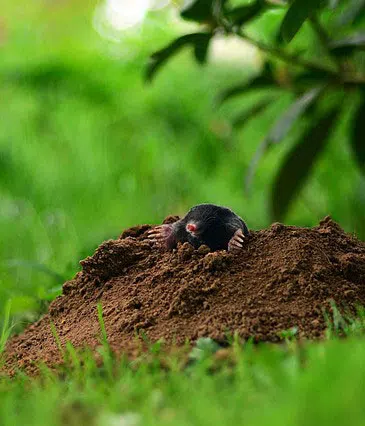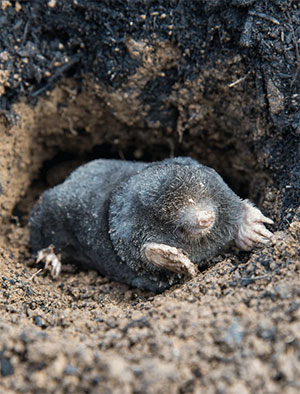Moles (not to be cofused with gophers) are small, subterraineal mammals, found on every continent except Antarctica and South America. Their eyes are poorly developed, but what they lack in sight, they make up for in their sense of touch, as well as a sixth digit on each paddle shaped front paw - perfect for burrowing tunnels. Adult moles grow up to 8 inches in length.

Moles have dense, silky fur that sticks straight up, preventing soil from becoming trapped in their coats when they back up through their tunnels.
 How to Identify Moles in Your Yard
How to Identify Moles in Your Yard
If you landed on this page, you are likely wondering "How to get moles out of my yard?". Let's first identify what's digging up your lawn. Moles are expert diggers that create characteristic volcano-shaped hills in your lawn. Moles can add 150 feet of new tunnels in your lawn each day.
Mole Hill
Moles hills (or mounds) will appear above the surface as round or oval-shaped mounds of dirt, often displaying an indent in the middle. Molehills can be quite large, measuring as big as 2 feet in diameter and 9 inches in height. That's pretty impressive for a small mammal that's only 5 to 8 inches long.
Why Moles Invade Your Yard
Especially if you are maintaining a beautiful lawn and yard, the last thing you'll want to discover, is moles. While their fondness for white grubs (a common lawn pest) may be beneficial, their underground activities will disturb roots and potentially damage and destroy plants - and mole hills in your yard probably don't add to the aesthetic appeal of your yard. So, if dig into how to get rid of moles in your yard and avoid garden damage.
Food Sources
While moles are classified as insectivores, or insect and insect larvae eaters, they'll also snack on worms, snails, and spiders. A favourite mole delicacy is the white grub. Additionally, the star-nosed mole, who is an excellent swimmer that will eat fish and aquatic invertebrates. In short, the mole is somewhat of an opportunistic eater - consuming pretty much whatever crosses its path. This makes sense, given its body shape and odd front paws - the mole is not built to give chase.
Interesting fact: Moles consume 60% - 100% of their body weight in insects, grubs, and other unpleasant creatures each day. This equates to a 5-ounce mole eating 50 pounds of food every year!
Soil Conditions
The ideal soil for moles and their burrowing activities is soft, loose or loamy, moist soil. Moles are usually found in soil, rich in organic matter. Their presence in unusually large numbers might may pointto a higher than normal population of soil pests. This can serve as an indicator that all is not well with the soil life.
Shelter
Moles shelter underground. The deeper the tunnel, the more permanent or important the shelter. Tunnels between 6 and 24 inches deep below ground are typically where moles will shelter during severe weather conditions. Moles will dig tunnels at a rate of up to 18 feet per hour. They are typically solitary, aggressively defending their territory from other moles, if necessary. In areas with a high mole population, territories or homeranges may somewhat overlap.
Breeding Grounds
Moles will bear their young in nesting chambers. These chambers are at the ends of tunnels and serve as bedrooms and birthing areas. Moles breed between March and May and after a 4-6 week gestation period, a litter of usually 3-5 hairless pups is born. By mid-summer, the young are able to care for themselves.
While burrows are generally not shared (except in areas of particularly high mole density), the territories or "homeranges" of moles do overlap. During the spring breeding season and when females are rearing the young are the only times moles will deliberately cohabitate.
 Humane Methods for Mole Control
Humane Methods for Mole Control
Aside from going out and purchasing a mole trap, specifically designed to catch moles, there are a few things you can try to discourage moles from settling into - or under - your yard.
Habitat Modification
The only real change you can make to mole habitat, is to change the composition of the soil to a mixture of heavy clay and rocks. This will create a habitat that is inhospitable to moles, but also have an impact on vegetation (existing and future plants). You could also pack the soil with a roller but again, this will negatively impact your existing plants. P:erhaps reducing soil moisture is a better option, so long as your plants can survive with less water.
Natural Repellents
Castor oil and castor oil products are often cited, but have shown very limited success in repelling moles. Moles tend to dislike daffodils, marigolds, and other plants in the allium family because of their strong scents.
Exclusion Techniques
For small area, you can install a fence of 24-inch roll hardware cloth. Dig down at least a foot and place fence, then bend at a 90o angle to cover the surfact. Essentially, you are creating an L-shape with the wire and sticking one end into the ground. Again, you'll need to go down a minimum of 12 inches.
For larger areas, you can dig a trench roughly 6 inches wide and two feet deep. Backfill with rocks or line it with wire (hardware cloth) to prevent moles and other burrowing pests from invading garden space.
Preventing Future Mole Invasions
As we've seen, there isn't a whole lot we can do to discourage moles from moving in. Let's sum up our options:
- Yard Maintenance: Keep your lawn tidy to eliminate shelter they can use (remove wood stacks or debris piles)
- Reduce soil moisture
- Plant flowers like marigolds or daffodils
- Install Hardware Cloth fence
- Dig trench and backfill with rocks or wire
Got an Animal Problem? Contact Hawkeye Bird & Animal Control!
Effective Mole Control probably comes down to trapping and relocation. While you may find any number of repellents, both DIY and commercially available, none have proven particularly effective. Please do stay away from any toxicants - poisons are NOT a humane option to deal with any pest animal and often injure or kill those not targeted.
Contact Hawkeye Bird & Animal Control for help with Moles and other pest wildlife in your Backyard!














